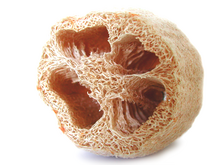Sponge gourd
| Sponge gourd | ||||||||||||
|---|---|---|---|---|---|---|---|---|---|---|---|---|

Sponge gourd ( Luffa aegyptiaca ), illustration |
||||||||||||
| Systematics | ||||||||||||
|
||||||||||||
| Scientific name | ||||||||||||
| Luffa aegyptiaca | ||||||||||||
| Mill. |
The sponge gourd ( Luffa aegyptiaca , often also Luffa cylindrica or, based on the Latin Luffa-Cucumber ) is an old world crop that belongs to the cucurbitaceae .
features
The sponge gourd, like all members of the genus Luffa up to 15 meters long expectant, prostrate or ascending climber . The stem axis is pentagonal and slightly hairy. The 1–15 centimeters long stalked leaves are large (up to 18 cm × 23 cm), slightly to deeply lobed and have white to silvery spots in the nerve branches. The tendrils are divided three to five times.
The male flowers are in clusters with 7 to 32 long, finely hairy inflorescence stalks. The flower stalks are three to twelve millimeters long, also finely hairy. The bracts are fused with the flower stalks, spatulate, glandular and two to six millimeters long. The flower tube is finely haired and three to seven millimeters long. The calyx lobes are 9-14 millimeters long, triangular, pointed and sometimes glandular. The corolla is bright yellow, the petals 2–4.5 inches long and 1–3.5 inches wide. Usually there are five stamens , rarely three.
The female flowers stand individually on a 2.5–14.5 centimeter long peduncle. The ovary is 20–40 millimeters long and two to seven millimeters wide, cylindrical and densely hairy. The crown corresponds to that of the male flowers.
The fruit is (6–35) cm × (2.5–6) cm in size. Cultivated specimens have an average length of 60 to 80 centimeters. Larger specimens are possible depending on the cultivation area, if there is mineral-rich soil. The shape is ellipsoidal to cylindrical. The seeds are (10-15) mm × (6-11) mm × (2-3) mm in size, broadly elliptical, rounded at the ends, flat, and with a narrow, winged edge. The surface is matt black and smooth.
The number of chromosomes is 2n = 26.
distribution
Wild forms occur from southern Central Asia to northeast Australia and the South Pacific. The domesticated forms are also common throughout tropical Asia, Africa, America and Latin America. The species naturally grows on river banks up to 1,000 meters above sea level.
Cultivation

The sponge gourd thrives best on fertile, slightly acidic to neutral soils in the sunny, hot and humid tropics. It is cultivated in the dry season, with cultivation up to 1000 meters above sea level. The most important growing countries are Egypt, Korea, China, Guatemala, Colombia and Paraguay. Pumpkins are also grown commercially in the southern United States.
There are a number of land races and varieties. There is great diversity in China; long-fruity varieties such as 'Xian-si-kua' (鲜 丝瓜Xiānsīguā ) and 'Hu-Lu-qing' (葫芦Húlu ) are grown on the Yangtze , the fruits of which are up to 150 centimeters long.
Unripe fruits can be harvested 40 to 80 days after sowing, ripe fruits three months later. For commercial processing as a natural sponge, the harvest time falls on the period when the fruiting body takes on the yellow color and is covered with small brown spots. In Japan, yields of up to 50 tons per hectare are achieved for ripe fruits.
use
In the West, the sponge gourd is used almost exclusively as a so-called loofah sponge : The fibrous interior of the (ripe) fruit ( endocarp ) is used as a massage and bath sponge in various designs, but also for kitchen scrubbers, animal toys, sandal soles, upholstery fillings, etc. a. processed. In the early 20th century, the sponges were also used as oil filters , especially in steamships - at that time Japan and Brazil were the main suppliers.
In Asia, the sponge gourd is primarily a vegetable : the young, still unripe fruit is widely used in Asian cuisine , similar to the zucchini in the West.
Panels for house and furniture construction are made in Paraguay from the sponge gourd, combined with other plant materials and plastic waste .
Taxonomy
In addition to the name Luffa aegyptiaca , Luffa cylindrica (L.) Roem is also known . often in use. However, according to the Standing Committee on Stabilization of Specific Names, Luffa aegyptiaca Mill. Is the valid name. Further synonyms are Momordica luffa L. and Momordica cylindrica L. , both published by Linné in his Species Plantarum 1753. However, the species was later transferred to a new genus Luffa by Miller .
literature
- RW Robinson, DS Decker-Walters: Cucurbits . CAB International, Wallingford 1997, pp. 94-97, ISBN 0-85199-133-5
- C. Jeffrey: Luffa cylindrica . In: Flora Zambesiaca , Volume 4, 1978 ( online ) (characteristics)
Individual evidence
- ^ Luffa aegyptiaca at Tropicos.org. In: IPCN Chromosome Reports . Missouri Botanical Garden, St. Louis
- ↑ Paraguay's new houses (2009) ( Memento from July 21, 2012 in the Internet Archive )
- ^ BG Schubert: Report of the Standing Committee on Stabilization of Specific Names . Taxon, Vol. 24, 1975, pp. 171-177.

